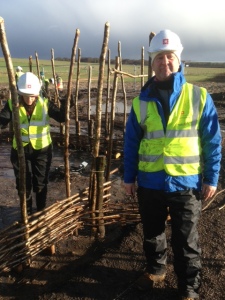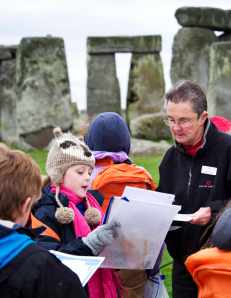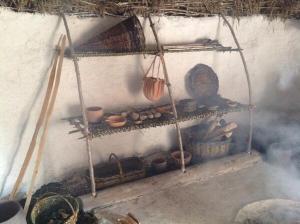
Meet the team: Nick Jones
The project is coming on a pace, despite the awful weather we have been having, which has meant that we’ve had to cancel one or two days builds.
Each week of the build we will be meeting one of the team of hardy volunteers who are braving the rain, wind and mud! This week we meet Nick Jones.
What made you want to get involved with the Neolithic Houses project?
I saw it as a wonderful learning opportunity – something that would improve my understanding of the Stonehenge World Heritage Site, and hopefully make me a better tour guide. I like working out of doors (my background is in architecture and environmental education), and I thought, ‘How extraordinary to be able to influence the Stonehenge landscape!’
What are you enjoying about the project so far?
It is giving me all I hoped for, and more. I enjoy the practical construction process, and the interesting questions continually being raised, but I also enjoy the growing bond between the volunteers. Although we came with diverse interests, motivations and expectations, we now have a strong sense of common purpose and pride in doing something special. I suspect it will last beyond the project, and I hope it will bring us back together to do other things.
Is there any part of the project that you’re particularly looking forward to or that you are particularly interested in?
Not really. I enjoy it all, although I am looking forward to Mother Nature actually letting us get on with the job! I am interested in finding out more about climate changes since the end of the last Ice Age, and how these may have influenced how people lived and the monuments they built.
In what ways has being involved in this project made you think differently about the people of Stonehenge and their lives?
I have always wondered how the monument came about. ‘OK lads, I’ve got an idea. Trust me, it will look great when it’s finished! All we have to do is walk 180 miles to Preseli and…” Who was in charge, who was navigating, and who made the sandwiches? The project has made me think about all the other people and processes that supported everyday life: the woodland managers, who produced coppice for building; the flint knappers, who made and repaired all the axes; the chalk-pounders, who made daub for the walls and laid the floors; the thatchers, who collected and fixed the various materials to keep the rain out; and so on. House building was probably a cultural institution – ie everyone joined in, and everyone knew what needed to be done – fun for all the family!
What do you do when you’re not building Neolithic houses?
In the summer I am a driver guide, which means I drive mostly well-off, and mostly American, tourists around England and Wales. They stay in 5* hotels, and I get a B&B down the road. I specialise in World Heritage Sites – places like Bath (where I live), Blenheim Palace, the Jurassic Coast etc – but I also do a lot of the Cotswolds, Oxford, Stratford upon Avon, and so on. I love exploring new places! I also do a bit of consultancy in world heritage matters. Apart from that, I do a lot of ironing and hoovering because my partner has a proper job.
What would you say to people who are tempted to volunteer at Stonehenge?
I might say remember Oscar Wilde, who said, ‘I can resist anything except temptation’. But he also said, ”It is better to have a permanent income than to be fascinating’. So, I would say, ‘Ignore Oscar Wilde!’ What you want to find at Stonehenge, you probably will.
————-
Thanks Nick!
Additional Volunteering Opportunities
If you are interested in beoming a Stonehenge Neolithic House Interpretation Volunteer, you can find out more on the English Heritage website. As a Neolithic House Interpretation Volunteer you will be responsible for maintaining the Neolithic houses once they are built (which weather permitting will be by the end of April), by lighting fires and assisting with the building maintenance. You will bring the stories of the Neolithic people to life in our external galleries and provide a warm and friendly welcome for all visitors, helping us to deliver a world class visitor experience.







